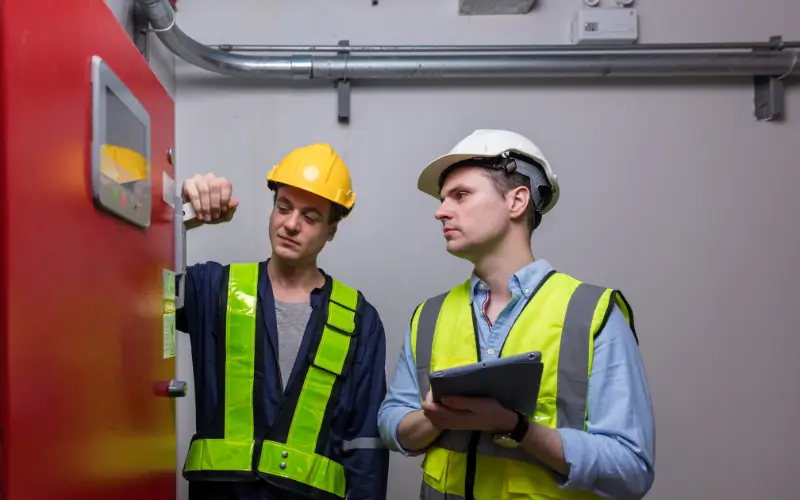The garments industry is one of the most energy-intensive sectors in manufacturing. From dyeing and washing to cutting, stitching, and finishing, factories consume significant amounts of electricity, steam, compressed air, and fuel. In countries where energy prices are rising or grid reliability is low, these costs can eat deep into profit margins.
That’s why energy audits have become essential tools for factory owners and managers. But many ask a critical question before investing in one:
“What is the financial ROI of an energy audit in the garments sector?”
An energy audit is more than just a checklist of recommended improvements—it is a structured approach to finding hidden savings and boosting operational efficiency. Done right, an audit can identify measures that reduce energy bills by 10–30%, with payback periods often less than two years.
In this comprehensive guide, we’ll break down:
- What an energy audit is in the garments context
- How to calculate its ROI step by step
- Typical costs and savings
- Case studies and industry benchmarks
- Practical tips to maximize your return on investment
Whether you’re an owner, factory manager, sustainability officer, or consultant, this post will help you make an informed, financially sound decision about investing in an energy audit for your garments facility.
Understanding Energy Audits in the Garments Sector
Below is the detailed, SEO-optimized content for this section, with H3 subheadings and clear, professional yet easy-to-read language.
What is an Energy Audit?
An energy audit is a systematic assessment of a facility’s energy use with the goal of identifying opportunities to reduce consumption and costs.
In simple terms, it’s like a health check-up for your factory’s energy systems. It identifies:
- Where energy is being used
- Where it is wasted
- How to reduce waste cost-effectively
Types of energy audits commonly used in the garments sector include:
- Walkthrough Audit: Quick, low-cost survey to spot obvious savings opportunities.
- Detailed Audit: In-depth data collection, measurements, and analysis to quantify savings and costs of improvements.
- Investment-Grade Audit: Highly detailed study used to support financing decisions; includes precise savings forecasts and implementation plans.
An energy audit typically produces a clear report with recommendations ranked by cost, savings, and payback period.
Why Do Garments Factories Need Energy Audits?
The garments sector is under enormous pressure to cut costs and meet sustainability targets. Energy is one of the highest controllable expenses in most factories—often second only to labor.
Key reasons garments factories benefit from energy audits include:
High Energy Consumption Areas:
- Boilers for steam (dyeing, washing)
- HVAC systems (climate control for production)
- Compressed air systems
- Lighting for large production floors
- Motors and pumps
These systems are often old, oversized, or poorly maintained, leading to waste.
Competitive Cost Pressures:
Brands and buyers demand lower prices while maintaining quality. Reducing energy costs can directly improve margins without compromising production.
Sustainability and Compliance Goals:
Many global buyers have strict sustainability requirements. An energy audit helps factories comply with certifications like LEED, ISO 50001, and various buyer-specific environmental audits.
Strategic Advantage:
Beyond cost savings, being seen as a green, efficient factory can win more orders from sustainability-focused brands.
The Concept of ROI in Energy Audits
Below is the detailed, SEO-optimized content with H3 subheadings that clearly explains ROI in the context of energy audits for the garments sector.
What is ROI in This Context?
ROI (Return on Investment) measures how much benefit you get back compared to what you spent.
In the context of an energy audit for a garments factory, ROI is the financial return generated from implementing the energy-saving measures recommended in the audit.
Basic ROI Formula:
ROI= Net Savings / Audit cost+ Implementation Cost×100
Key Concepts:
- Net Savings: Total annual energy cost reductions minus any increase in operating/maintenance costs.
- Audit Cost: The fee paid to the consultant or firm conducting the audit.
- Implementation Cost: Capital or operational expenses to install or adopt the recommended improvements.
Why ROI Matters:
ROI helps factory owners and managers:
- Evaluate if the energy audit is financially worthwhile.
- Prioritize improvements with the highest returns.
- Convince management or investors to fund energy-saving projects.
Payback Period Concept
Another critical metric is payback period—the time it takes for savings to recover the initial investment.
Payback Period Formula:
Payback Period= Total Investment / Annual Savings
Example:
- Total audit + implementation cost: $20,000
- Annual energy savings: $10,000
- Payback period = 2 years
Shorter payback periods (often 1–3 years in garments sector) make investments more attractive.
Net Present Value (NPV) and Lifecycle Savings
For large investments, many factories also consider NPV—which accounts for the time value of money over the project’s lifetime.
NPV tells you:
- The total value today of all future savings minus costs.
- Whether the project adds value even after accounting for financing costs.
Lifecycle savings:
- Total savings over the lifespan of the improvements (often 5–15 years).
- A critical selling point for management and buyers focused on sustainability.
Typical Costs of an Energy Audit
Industry Range:
- Walkthrough Audit: $1,000–$5,000 (small factories)
- Detailed Audit: $5,000–$20,000
- Investment-Grade Audit: $15,000–$50,000+
Factors Affecting Cost:
- Size and complexity of factory
- Number of systems analyzed (steam, HVAC, compressed air, lighting, motors)
- Depth of measurement and analysis
- Experience and reputation of audit firm
Benefits of Energy Audits in Garments Industry
Direct Energy Cost Savings
The most immediate and measurable benefit of an energy audit is reducing energy bills.
Audits typically identify:
- Inefficient boilers consuming excess fuel
- Leaky steam lines wasting energy
- Oversized or underloaded compressors
- Old or poorly maintained motors
- Inefficient lighting systems
Typical savings in garments sector:
- 10–30% reduction in total energy costs.
Example impact:
- Factory with $100,000/year energy spend
- 20% savings = $20,000/year saved
- Payback on improvements often under 2 years.
Operational Efficiency Gains
An energy audit doesn’t just save energy—it improves overall production efficiency.
Benefits include:
- Fewer equipment breakdowns from better maintenance.
- Optimized processes reducing waste and defects.
- Reduced unplanned downtime thanks to monitoring and control improvements.
- Smoother, more predictable production schedules.
Result:
- Lower maintenance costs and improved delivery reliability for buyers.
- Environmental and Regulatory Benefits
- Garments factories face increasing pressure to reduce environmental impact.
Energy audits help:
- Lower CO₂ emissions by reducing fossil fuel use.
- Comply with local energy efficiency regulations.
Qualify for international certifications like:
- LEED (Leadership in Energy and Environmental Design)
- ISO 50001 (Energy Management Systems)
- Brand/buyer-specific sustainability requirements.
Strategic advantage:
- Better environmental compliance reduces regulatory risk and fines.
Brand and Market Benefits
Today’s buyers care about sustainability—and so do consumers.
How energy audits help secure orders:
- Demonstrate commitment to reducing carbon footprint.
- Win sustainability-focused brands seeking low-impact suppliers.
- Improve scoring in brand audits and supplier evaluations.
- Strengthen marketing and branding as a green factory.
Buyer expectations:
Major brands increasingly require suppliers to demonstrate energy efficiency initiatives, audit participation, and verifiable savings.
How to Calculate the ROI of an Energy Audit
Step-by-Step ROI Calculation
Calculating the ROI of an energy audit in a garments factory is a practical, data-driven process. Here’s how you can do it:
1️ Define the Audit Cost
This is the fee paid to the auditor or consulting firm.
- Example: $5,000 for a detailed audit.
- Costs vary by factory size and audit type (walkthrough vs detailed vs investment-grade).
2️ Estimate Annual Energy Savings
Use the audit report to quantify expected savings.
- Auditors typically provide estimates of kWh or fuel saved per year.
- Convert to monetary value using local energy prices.
Example calculation:
- Electricity savings: 50,000 kWh/year × $0.10/kWh = $5,000
- Natural gas savings: 20,000 m³/year × $0.30/m³ = $6,000
- Total annual savings: $11,000
3️ Calculate Implementation Cost
Cost to actually implement the auditor’s recommendations.
- Lighting upgrades
- Steam trap replacements
- Insulation improvements
- Motor replacements
- Control system installations
Example:
- Total implementation cost: $15,000
4️ Compute Payback Period
Formula:
Payback Period = Audit Cost + Implementation Cost / Annual Savings
Example:
- Total cost = $5,000 (audit) + $15,000 (implementation) = $20,000
- Annual savings = $11,000
- Payback period ≈ 1.8 years
Interpretation:
- Investment pays for itself in less than 2 years.
- After payback, savings continue each year.
5️ Compute ROI Percentage
Formula:
ROI = Total Net Savings Over Project Life / Total Investment × 100
ROI=
Example over 5 years:
- Total savings = $11,000 × 5 = $55,000
- Total investment = $20,000
- ROI = (55,000 – 20,000) / 20,000 × 100 = 175%
Interpretation:
- For every $1 invested, the factory gets $2.75 back in savings over 5 years.
Example ROI Calculation for a Garment Factory
Case Example: Mid-sized woven garments factory in Bangladesh.
- Audit cost: $7,500
- Implementation cost: $25,000
- Annual energy savings: $16,000
- Payback period: (7,500 + 25,000) / 16,000 ≈ 2 years
- 5-year net savings = $80,000
- ROI over 5 years = (80,000 – 32,500) / 32,500 × 100 ≈ 146%
This is typical in the industry: payback periods of 1.5–3 years and ROI of 100–300% over 5 years.
Factors Impacting ROI in Garments Sector
Factory Size and Energy Intensity
Larger factories usually see higher absolute savings because:
- They consume more energy overall.
- Efficiency upgrades have a bigger impact.
Energy-intensive operations:
- Dyeing, washing, and finishing units use significant steam and hot water.
- Climate control in large production floors requires substantial HVAC energy.
Smaller factories can still see strong ROI if they have obvious inefficiencies (e.g., outdated lighting, leaking compressed air systems).
Type of Audit Conducted
ROI varies with audit depth:
- Walkthrough audits are cheap but may miss savings opportunities.
- Detailed audits cost more but identify deeper, more cost-effective improvements.
- Investment-grade audits provide precision forecasts needed for financing.
Choosing the right audit type balances cost with potential savings.
Implementation Rate of Recommendations
Energy audits only deliver savings if recommendations are actually implemented.
- Some factories ignore low-priority or higher-cost measures.
- Partial implementation reduces overall ROI.
Best practice:
- Prioritize measures with the shortest payback.
- Plan phased implementation for budget management.
- Monitor progress to ensure savings materialize.
Energy Prices and Utility Incentives
Local energy prices directly affect ROI:
- Higher prices = greater savings potential.
- Factories in regions with frequent fuel price hikes see faster payback.
Incentives and subsidies can improve ROI:
- Government or donor programs may fund part of the audit cost.
- Utility rebates may reduce upgrade costs (e.g., efficient boilers, motors, lighting).
- Financing options (e.g., energy performance contracts) can spread costs over time.
Maintenance Practices and Staff Engagement
Even the best upgrades underperform without proper maintenance.
- Poor maintenance reduces savings and lengthens payback periods.
- Well-trained staff ensure systems operate at optimal efficiency.
Successful factories embed energy efficiency into their culture:
- Routine monitoring.
- Regular training.
- Incentivized energy-saving practices.
Case Studies and Industry Benchmarks
Real-World Examples
Example 1: Bangladesh Knitwear Factory
- Audit type: Detailed energy audit
- Key measures: Steam system insulation, efficient boilers, LED lighting retrofit
- Investment cost: $18,000
- Annual savings: $9,000
- Payback period: 2 years
- 5-year ROI: ~150%
Result:
- Improved buyer sustainability scores
- Reduced downtime from better-maintained steam system
Example 2: Vietnam Woven Garments Plant
- Audit type: Investment-grade audit
- Measures: HVAC optimization, high-efficiency compressors, automated controls
- Investment cost: $50,000
- Annual savings: $22,000
- Payback period: ~2.3 years
- 5-year ROI: ~120%
Result:
- Secured orders from a major sustainability-focused European brand
- Qualified for green financing with reduced interest rates
Example 3: India Denim Factory
- Audit type: Walkthrough audit
- Measures: Steam leak repairs, compressor controls
- Investment cost: $6,000
- Annual savings: $4,000
- Payback period: 1.5 years
- 5-year ROI: ~230%
Result:
- Low-cost improvements with very fast payback
- Foundation for future detailed audit
Textile Industry ROI Benchmarks
According to industry studies and development agencies:
- Typical energy savings range: 10–30% of annual energy costs.
- Typical payback periods: 1–3 years.
- ROI over 5 years: 100–300%.
Factors in benchmarks:
- Region and energy prices
- Factory size and energy intensity
- Depth of audit and quality of implementation
Key Source Examples (for context in blog writing):
- UNIDO (United Nations Industrial Development Organization) reports on energy efficiency in textiles.
- IFC (International Finance Corporation) case studies on Bangladesh’s textile sector.
- National industry associations or energy efficiency agencies.
You can optionally cite these in your final post or link to them for credibility.
Tips to Maximize ROI from an Energy Audit
Choose the Right Type of Audit
Don’t underinvest or overinvest:
- Walkthrough Audit: Best for small factories with obvious, low-cost fixes.
- Detailed Audit: Suitable for medium to large factories needing a roadmap for major savings.
- Investment-Grade Audit: Ideal if you need financing or have large, complex systems.
Prioritize High-Impact Measures
Focus on measures with:
- Shortest payback periods.
- Highest absolute savings.
- Minimal operational disruption.
Common high-impact upgrades in garments factories:
- Boiler insulation and steam trap maintenance.
- Efficient compressors and leak detection.
- LED lighting and daylight optimization.
- Variable speed drives for motors.
- HVAC optimization.
Best Practice:
Create a prioritized action plan with costs, savings, and timelines.
Secure Management Buy-In
ROI depends on implementation.
Management support is critical to:
- Allocate budget.
- Approve projects.
- Motivate teams.
Strategy:
- Present clear ROI calculations.
- Use case studies to show credibility.
- Align energy savings with cost-reduction and sustainability goals.
Train Staff on Best Practices
Savings depend on operations, not just equipment.
Examples of training topics:
- Efficient boiler operation.
- Proper compressor use.
- Turning off idle machines.
- Leak detection and quick repair.
Benefit:
Well-trained staff maintain savings year after year.
Monitor and Verify Savings
Measurement and Verification (M&V) ensures projected savings become real savings.
Steps:
- Baseline energy use before upgrades.
- Regularly track post-implementation energy bills.
- Adjust operations as needed.
Tools:
- Smart meters.
- Energy management software.
- Periodic mini-audits.
Benefit:
Continuous improvement and accountability.
Is an Energy Audit Worth It for Garments Factories?
Summing Up Financial Arguments
The numbers speak clearly:
- Energy audits uncover savings that typically deliver 10–30% reductions in energy costs.
- Payback periods usually range between 1 to 3 years, which is a relatively short time for capital investments.
- Over a typical 5-year project life, the ROI often exceeds 100%, meaning the factory doubles its investment in savings.
Energy audits are investments, not expenses. The upfront costs are quickly recouped through lower bills and increased operational efficiency.
Beyond Money: Strategic Advantages
Sustainability Credentials:
- Buyers increasingly demand transparent energy management and emissions reductions.
- Audits help factories meet buyer requirements and qualify for certifications like LEED and ISO 50001.
Competitive Edge:
- Energy-efficient factories often win more contracts from global brands emphasizing sustainability.
- They build stronger, more resilient businesses in an evolving market.
Risk Reduction:
- Energy audits help identify operational risks such as equipment failures or safety hazards related to energy systems.
Cultural Shift:
- Embedding energy efficiency fosters a culture of continuous improvement and environmental responsibility.
Conclusion
Energy costs in the garments sector continue to rise, putting pressure on factories to improve efficiency and reduce expenses. Conducting an energy audit is a proven, effective way to identify cost-saving opportunities, reduce environmental impact, and enhance operational performance.
By understanding the financial ROI of an energy audit, garment factory owners and managers can make confident decisions about investing in energy efficiency measures. Typical payback periods of 1 to 3 years and ROI exceeding 100% over five years demonstrate the clear economic value.
Beyond direct savings, energy audits strengthen sustainability credentials, improve buyer relationships, and reduce operational risks—making them a strategic asset in today’s competitive textile market.
If you haven’t yet conducted an energy audit for your garments factory, now is the time to explore this investment that pays for itself and future-proofs your business.
FAQs
Q1: What is the typical ROI of an energy audit in garments?
Most garments factories see an ROI of 100% to 300% over 5 years, with payback periods between 1 and 3 years.
Q2: How long does it take to get a payback from energy audit investments?
Payback typically occurs within 1 to 3 years depending on the scope and implementation.
Q3: Who conducts energy audits for garments factories?
Energy consultants, engineering firms, and specialized auditors with textile industry experience typically conduct these audits.
Q4: Is it mandatory for garments factories to conduct energy audits?
Requirements vary by country, but many regions and buyers encourage or require energy audits for compliance or certification.
Q5: How can small factories afford energy audits?
Small factories can start with walkthrough audits, seek government subsidies or donor funding, or join collective programs to reduce costs.




